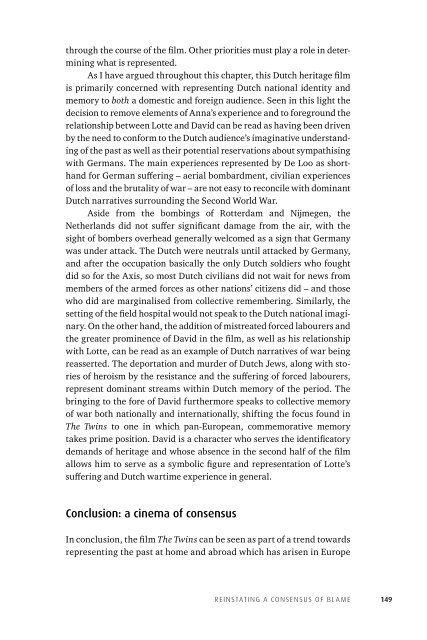Discord Consensus
7aze300jFJo
7aze300jFJo
You also want an ePaper? Increase the reach of your titles
YUMPU automatically turns print PDFs into web optimized ePapers that Google loves.
through the course of the film. Other priorities must play a role in determining<br />
what is represented.<br />
As I have argued throughout this chapter, this Dutch heritage film<br />
is primarily concerned with representing Dutch national identity and<br />
memory to both a domestic and foreign audience. Seen in this light the<br />
decision to remove elements of Anna’s experience and to foreground the<br />
relationship between Lotte and David can be read as having been driven<br />
by the need to conform to the Dutch audience’s imaginative understanding<br />
of the past as well as their potential reservations about sympathising<br />
with Germans. The main experiences represented by De Loo as shorthand<br />
for German suffering –aerial bombardment, civilian experiences<br />
of loss and the brutality of war –are not easy to reconcile with dominant<br />
Dutch narratives surrounding the Second World War.<br />
Aside from the bombings of Rotterdam and Nijmegen, the<br />
Netherlands did not suffer significant damage from the air, with the<br />
sight of bombers overhead generally welcomed as a sign that Germany<br />
was under attack. The Dutch were neutrals until attacked by Germany,<br />
and after the occupation basically the only Dutch soldiers who fought<br />
did so for the Axis, so most Dutch civilians did not wait for news from<br />
members of the armed forces as other nations’ citizens did –and those<br />
who did are marginalised from collective remembering. Similarly, the<br />
setting of the field hospital would not speak to the Dutch national imaginary.<br />
On the other hand, the addition of mistreated forced labourers and<br />
the greater prominence of David in the film, as well as his relationship<br />
with Lotte, can be read as an example of Dutch narratives of war being<br />
reasserted. The deportation and murder of Dutch Jews, along with stories<br />
of heroism by the resistance and the suffering of forced labourers,<br />
represent dominant streams within Dutch memory of the period. The<br />
bringing to the fore of David furthermore speaks to collective memory<br />
of war both nationally and internationally, shifting the focus found in<br />
The Twins to one in which pan-European, commemorative memory<br />
takes prime position. David is a character who serves the identificatory<br />
demands of heritage and whose absence in the second half of the film<br />
allows him to serve as a symbolic figure and representation of Lotte’s<br />
suffering and Dutch wartime experience in general.<br />
Conclusion: a cinema of consensus<br />
In conclusion, the film The Twins can be seen as part of a trend towards<br />
representing the past at home and abroad which has arisen in Europe<br />
Reinstating a consensus of blame 149


